View in other NatureServe Network Field Guides
NatureServe
Montana
Utah
Wyoming
Idaho
Wisconsin
British Columbia
South Carolina
Yukon
California
New York
Columbia Lewisia - Lewisia columbiana
State Rank Reason (see State Rank above)
Rare and peripheral in Montana, where it is known from only one location in the Bitterroot Mountains. Its relatively inaccessible habitat reduces the potential for negative impacts.
General Description
Columbia lewisia is a succulent, glabrous perennial with several leafless stems, 5-15 cm (2-6 in) high, from a fleshy, unbranched rootcrown. Strap-shaped basal leaves are up to 4 cm (1 in) long. Stems have small leaf-like bracts with entire or toothed margins. Flowers are borne on short stalks subtended by a small gland-toothed bract in a branched, open inflorescence. Each flower has 2 glandular-toothed sepals, 1-2 mm long; 7-9 pinkish petals, 5-8 mm long; and 5-6 stamens. The fruit is a globose capsule, ca. 3 mm high, with 1-5 shiny black seeds. Our plants are variety wallowensis C.L. Hitchc.
Phenology
Flowering in June-July.
Diagnostic Characteristics
Lewisia columbiana is our only member of the Portulacaceae with gland-toothed bracts in the inflorescence.
Species Range
Montana Range
Range Descriptions

 Native
Native
Range Comments
Endemic to central ID and adjacent OR and one canyon in Ravalli County (Lesica et al. 2012. Manual of Montana Vascular Plants. BRIT Press. Fort Worth, TX).
Observations in Montana Natural Heritage Program Database
Number of Observations: 11
(Click on the following maps and charts to see full sized version)
Map Help and Descriptions
Relative Density
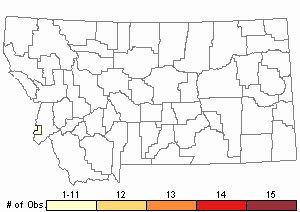
Recency
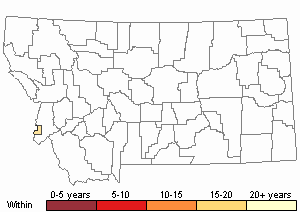
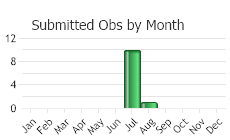
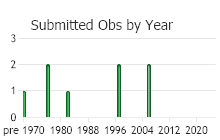
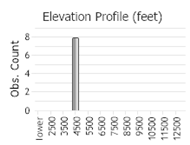 (Observations spanning multiple months or years are excluded from time charts)
(Observations spanning multiple months or years are excluded from time charts)
Habitat
Moist rock crevices in granite along streams in the foothill and montane zones.
National Vegetation Classification System Groups Associated with this Species
Sparse and Barren
Sparse and Barren
Stewardship Responsibility
Threats or Limiting Factors
STATE THREAT SCORE REASON
Reported threats to Montana’s populations of Columbia Lewisia are due to recreation activity where hiking trails are in the vicinity of the only known populations (MTNHP Threat Assessment 2021). The entire population is exposed to slight to moderately severe negative impacts.
References
- Literature Cited AboveLegend:
 View Online Publication
View Online Publication Lesica, P., M.T. Lavin, and P.F. Stickney. 2012. Manual of Montana Vascular Plants. Fort Worth, TX: BRIT Press. viii + 771 p.
Lesica, P., M.T. Lavin, and P.F. Stickney. 2012. Manual of Montana Vascular Plants. Fort Worth, TX: BRIT Press. viii + 771 p. MTNHP Threat Assessment. 2021. State Threat Score Assignment and Assessment of Reported Threats from 2006 to 2021 for State-listed Vascular Plants. Botany Program, Montana Natural Heritage Program, Helena, Montana.
MTNHP Threat Assessment. 2021. State Threat Score Assignment and Assessment of Reported Threats from 2006 to 2021 for State-listed Vascular Plants. Botany Program, Montana Natural Heritage Program, Helena, Montana.
- Additional ReferencesLegend:
 View Online Publication
View Online Publication
Do you know of a citation we're missing? Lesica, P., M.T. Lavin, and P.F. Stickney. 2022. Manual of Montana Vascular Plants, Second Edition. Fort Worth, TX: BRIT Press. viii + 779 p.
Lesica, P., M.T. Lavin, and P.F. Stickney. 2022. Manual of Montana Vascular Plants, Second Edition. Fort Worth, TX: BRIT Press. viii + 779 p. Lorain, C. C. 1988. Floristic history and distribution of coastal disjunct plants of the northern Rocky Mountains. M.S. thesis. College of Forestry, Wildlife, and Range Sciences, University of Idaho, Moscow. 221 pp.
Lorain, C. C. 1988. Floristic history and distribution of coastal disjunct plants of the northern Rocky Mountains. M.S. thesis. College of Forestry, Wildlife, and Range Sciences, University of Idaho, Moscow. 221 pp.
- Web Search Engines for Articles on "Columbia Lewisia"





